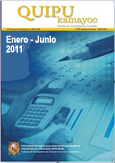STRATEGIC INVESTMENT FINANCING AND CAPITAL MARKETS IN PERU
DOI:
https://doi.org/10.15381/quipu.v18i35.3712Keywords:
Financiamiento de inversiones, inversiones estratégicas, inversión estratégica directa, mercado de capitales.Abstract
One of the fundamental criticisms of the Peruvian economic model, implemented by the government of the day, is that through the unrestricted opening of the domestic market to foreign investment can be achieved sustained economic growth. This is reflected in Article 63 of the 1993 Constitution, which reads: “The domestic and foreign investments are subject to the same conditions. So the foreign investors can enter any economic sector, from oil, mining, petrochemicals, airlines, ports, financial sector, telecommunications, etc. In this view, there are strategic sectors or enterprises; therefore, the State should be excluded from any interference or attempt to control. The objective of this research is to present proposals to reserve to-face strategic sectors of national capital funding in the Lima Stock Exchange, and take the opportunity to develop the capital market, looking for transparency in financial reporting, as companies open corporations, and avoid future cases such as Doe Run Peru, established as a Limited Liability Company Commercial. The methodology of this study is a descriptive, because it seeks to analyze, evaluate and explain the effects of current funding model for private investment by the indiscriminate opening of the domestic market to foreign direct investment. Collection was made documentary information from the Ministry of Economy and Finance (MEF), Central Bank of Peru (BCRP), National Supervisory Commission for Companies and Securities (CONASEV), analysts and other national and foreign experts in market capital. The results of this study will be reported in the 2010 Research Workshop of the School of Accounting of San Marcos, to be published an article in the Journal of Research “Quipukamayoc” of the Faculty and its findings submitted to the National Congress of the Republic, CONASEV, and Lima Stock Exchange (BVL). The objective of this research is to present proposals to amend the Constitution of Peru in the sense of maintaining a presence in strategic sectors of the national capital required to finance the Lima Stock Exchange, and take the opportunity to develop the capital market looking for transparency in financial reporting, as open corporations, and avoid future cases such as Doe Run Peru, established as a Limited Liability Company Commercial. Participating units are: the Ministry of Economy and Finance, Agency for Promotion of Private Investment (PROINVERSIÓN), the National Supervisory Commission for Companies and Securities (CONASEV), the Lima Stock Exchange. The results of this study were reported in the 2010 Research Workshop of the School of Accounting of San Marcos, and its findings submitted to the CONASEV STOCK EXCHANGE LIMA and PROINVERSIÓN. The main conclusion is to amend Article 60, third paragraph, of our current Constitution as follows: “Business, public or nonpublic, receives the same legal treatment. But investments in the sectors: Water and Sanitation and Hydroelectric Power, Gas, Oil, Research and Development, Ports and Airports, will be formed as open corporations and are obliged to put at least 20% of its share capital in Lima Stock Exchange”.
Downloads
Downloads
Published
Issue
Section
License
Copyright (c) 2011 Raúl Alberto Arrarte Mera

This work is licensed under a Creative Commons Attribution-NonCommercial-ShareAlike 4.0 International License.
AUTHORS RETAIN THEIR RIGHTS:
a. Authors retain their trade mark rights and patent, and also on any process or procedure described in the article.
b. Authors retain their right to share, copy, distribute, perform and publicly communicate their article (eg, to place their article in an institutional repository or publish it in a book), with an acknowledgment of its initial publication in Quipukamayoc .
c. Authors retain theirs right to make a subsequent publication of their work, to use the article or any part thereof (eg a compilation of his papers, lecture notes, thesis, or a book), always indicating the source of publication (the originator of the work, journal, volume, number and date).






